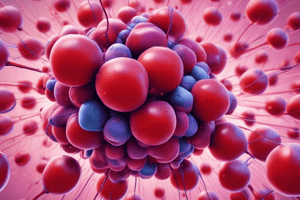Podcast
Questions and Answers
What is the main mechanism of action of heparins in promoting anticoagulation?
What is the main mechanism of action of heparins in promoting anticoagulation?
- Activating platelets via FcγIIa receptors
- Binding to circulating platelet factor 4 (PF4)
- Enhancing the activity of antithrombin (correct)
- Forming stable salts with sulfate protamine
Why have drugs like enoxaparin largely replaced unfractionated heparin (UFH) in clinical use?
Why have drugs like enoxaparin largely replaced unfractionated heparin (UFH) in clinical use?
- Increased binding to plasma and endothelial proteins
- Shorter half-life
- Higher risk of bleeding
- Improved bioavailability (correct)
What is the biggest disadvantage associated with the use of UFH and LMWHs?
What is the biggest disadvantage associated with the use of UFH and LMWHs?
- Potential for allergic reactions
- Development of heparin-induced thrombocytopenia (HIT) (correct)
- Risk of hypercoagulability
- High cost
Why is fondaparinux considered an appealing alternative to UFH and LMWHs?
Why is fondaparinux considered an appealing alternative to UFH and LMWHs?
What is the origin of unfractionated heparin (UFH)?
What is the origin of unfractionated heparin (UFH)?
How is the protein binding of enoxaparin different from UFH?
How is the protein binding of enoxaparin different from UFH?
What is the advantage of Vitamin K Antagonists (VKAs) over parenterally administered heparins?
What is the advantage of Vitamin K Antagonists (VKAs) over parenterally administered heparins?
Which anticoagulant requires sulfate protamine as a neutralizing agent in case of overdose?
Which anticoagulant requires sulfate protamine as a neutralizing agent in case of overdose?
Which of the following accurately describes the mechanism of action of Vitamin K antagonists (VKAs)?
Which of the following accurately describes the mechanism of action of Vitamin K antagonists (VKAs)?
Why are Vitamin K antagonists (VKAs) suitable for oral administration?
Why are Vitamin K antagonists (VKAs) suitable for oral administration?
How does Fondaparinux differ from unfractionated heparin (UFH) and low molecular weight heparins (LMWHs) in terms of structure?
How does Fondaparinux differ from unfractionated heparin (UFH) and low molecular weight heparins (LMWHs) in terms of structure?
Which coagulation factor is dependent on vitamin K for its conversion from an inactive zymogen to an active enzyme?
Which coagulation factor is dependent on vitamin K for its conversion from an inactive zymogen to an active enzyme?
Why does VKA treatment typically require a bridging period with a fast-acting heparin?
Why does VKA treatment typically require a bridging period with a fast-acting heparin?
What is the role of VKCOR1 in the context of vitamin K-dependent coagulation factors?
What is the role of VKCOR1 in the context of vitamin K-dependent coagulation factors?
Why is monitoring the international normalized ratio (INR) crucial during VKA treatment?
Why is monitoring the international normalized ratio (INR) crucial during VKA treatment?
How does exogenous vitamin K act as a neutralizing agent for VKAs?
How does exogenous vitamin K act as a neutralizing agent for VKAs?
What is the main difference between bivalirudin and argatroban compared to UFH and LMWH?
What is the main difference between bivalirudin and argatroban compared to UFH and LMWH?
How is the elimination process of bivalirudin different from that of warfarin?
How is the elimination process of bivalirudin different from that of warfarin?
What is the target of bivalirudin and argatroban in the context of anticoagulation?
What is the target of bivalirudin and argatroban in the context of anticoagulation?
Which anticoagulant has already reached peak activity within minutes after injection?
Which anticoagulant has already reached peak activity within minutes after injection?
Flashcards are hidden until you start studying



